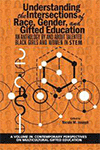
Understanding the Intersections of Race, Gender, and Gifted Education
An Anthology By and About Talented Black Girls and Women in STEM
Edited by:
Nicole M. Joseph, Vanderbilt University
A volume in the series: Contemporary Perspectives on Multicultural Gifted Education. Editor(s): Donna Y. Ford, Ohio State University. Malik S. Henfield, Loyola University Chicago.
Published 2020
This book seeks to understand the complexities of talented and high-performing Black girls and women in STEM across the P-20 trajectory. Analogously, this volume aims to understand the intersections between giftedness, its identification, and racial, gender, and academic discipline identities. The dearth of literature on this subject suggests that Black girls and women have unique experiences in gifted programming, in large part because of factors associated with gifted programs in general. Key factors affecting Black students, and Black girls in particular, are identification and underrepresentation. These factors can be shaped by interlocking systems of racism, classism, gender bias, and other forms of oppression.
Teachers in the P-12 educational system are the first identifiers for gifted programming and look for student characteristics, such as natural leadership, inquisitiveness, and students’ desire to be in gifted programs. Because many Black girls are stereotyped and teachers rarely have deep understanding of cultural differences, Black girls are less likely to be identified for gifted programming. More specifically, Black girls’ lack of representation in gifted mathematics or STEM programs contradicts research that finds that girls reach several developmental advantages ahead of boys. For example, research has shown that girls talk and read earlier, receive higher grades in elementary school, and drop-out less often than boys. Other studies have also shown that Black girls have higher mathematics career aspirations than their White and Latina female peers; yet, they are rarely represented in gifted math and Advanced Placement (AP) math programs. Furthermore, the underrepresentation of urban, low-income African-American students in gifted education is related to low test scores, student and family choice, a lack of teacher referral, and a mismatch between home and school cultures.
Some high-performing Black girls and women are participating in programs that nurture and support their racial and gender identities and contribute to them developing into strong and efficacious girls and women who have agency in their lives. This anthology includes studies that illustrate the complexities of intersectionality in various STEM programs, while also demonstrating that increasing access to STEM for Black girls and women is doable.
CONTENTS
Acknowledgements. Forward, Donna Y. Ford. Introduction, Nicole M. Joseph. Heaven Help Us: Insights into the Marginalization of Black Girls’ Giftedness, Natalie S. King and Rose M. Pringle. “I Just Get All Stressed Out”: Coping with Perfectionism as a Black Gifted Girl in Mathematics, Frances K. Harper and Brittany N. Anderson. Terms of Engagement: Redefining Parental Involvement and STEM Identity for Black Girls, Nicol R. Howard. Hidden in Plain Sight: Life Lessons Taught by Gifted Black Girls to their White STEM Teachers, Amanda R. Casto and Lenora Crabtree. A Counter-storytelling of Struggle and Support in Black Women’s Mathematical Talent Development and STEM Pursuits across White, Patriarchal Spaces in Education, Luis A. Leyva and Zander D. Alley. I Am Not Your Savioress: Consistently Honoring the Intrinsic Value of Black Women’s Intellectual Labor and Cultural Capital in STEM, Beronda L. Montgomery. A Gifted Black Femme Scientist Bends Toward Justice, Chanda Prescod-Weinstein. Epilogue, Joy Lawson Davis.
-
Paperback978-1-64113-963-2
Web price: $45.04 (Reg. 52.99)
-
Hardcover978-1-64113-964-9
Web price: $80.74 (Reg. 94.99)
- eBook978-1-64113-965-6

- EDU020000 - EDUCATION: Multicultural Education
- EDU026060 - EDUCATION: Special Gifted
- EDU029030 - EDUCATION: TEACHING METHODS & MATERIALS: Science & Technology
-
 A Second Helping of Gumbo for the Soul
More Liberating Stories and Memories to Inspire Females of Color
A Second Helping of Gumbo for the Soul
More Liberating Stories and Memories to Inspire Females of Color
-
 Black Boys are Lit
Engaging PreK-3 Gifted and Talented Black Boys Using Multicultural Literature and Ford’s Bloom-Banks Matrix
Black Boys are Lit
Engaging PreK-3 Gifted and Talented Black Boys Using Multicultural Literature and Ford’s Bloom-Banks Matrix
-
 Digital Technologies and Early Childhood in China
Policy and Practice
Digital Technologies and Early Childhood in China
Policy and Practice
-
 Gumbo for the Soul
Liberating Memoirs and Stories to Inspire Females of Color
Gumbo for the Soul
Liberating Memoirs and Stories to Inspire Females of Color
-
 Gumbo for the Soul III
Males of Color Share Their Stories, Meditations, Affirmations, and Inspirations
Gumbo for the Soul III
Males of Color Share Their Stories, Meditations, Affirmations, and Inspirations
-
 Identifying, Preventing and Combating Bullying in Gifted Education
Identifying, Preventing and Combating Bullying in Gifted Education
-
 Latinx College Students
Innovations in Mental Health, Advocacy, and Social Justice Programs
Latinx College Students
Innovations in Mental Health, Advocacy, and Social Justice Programs

